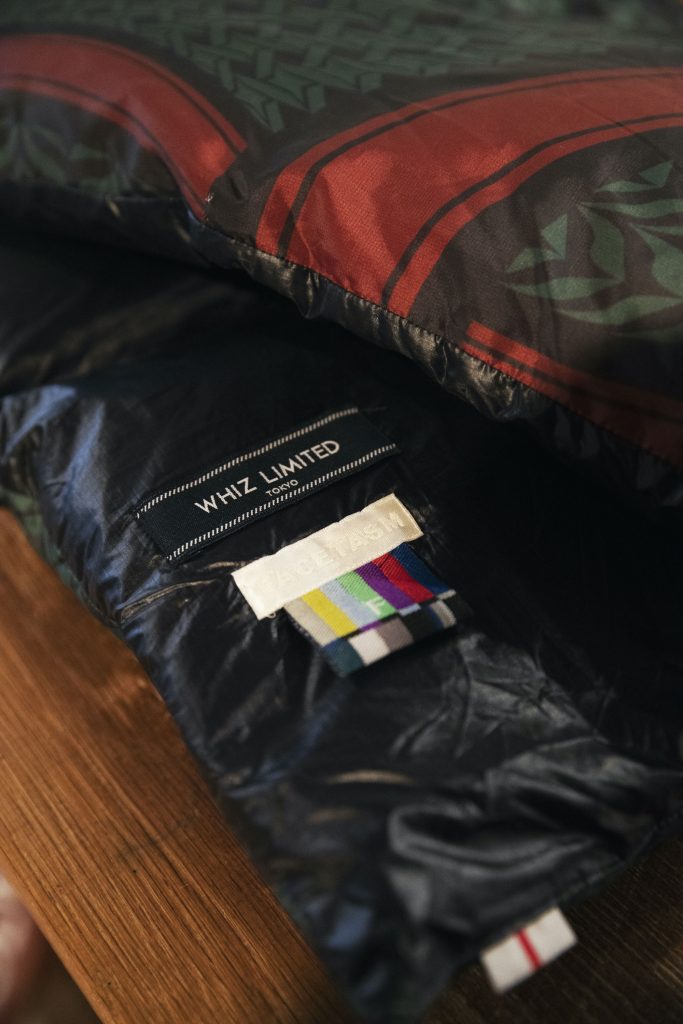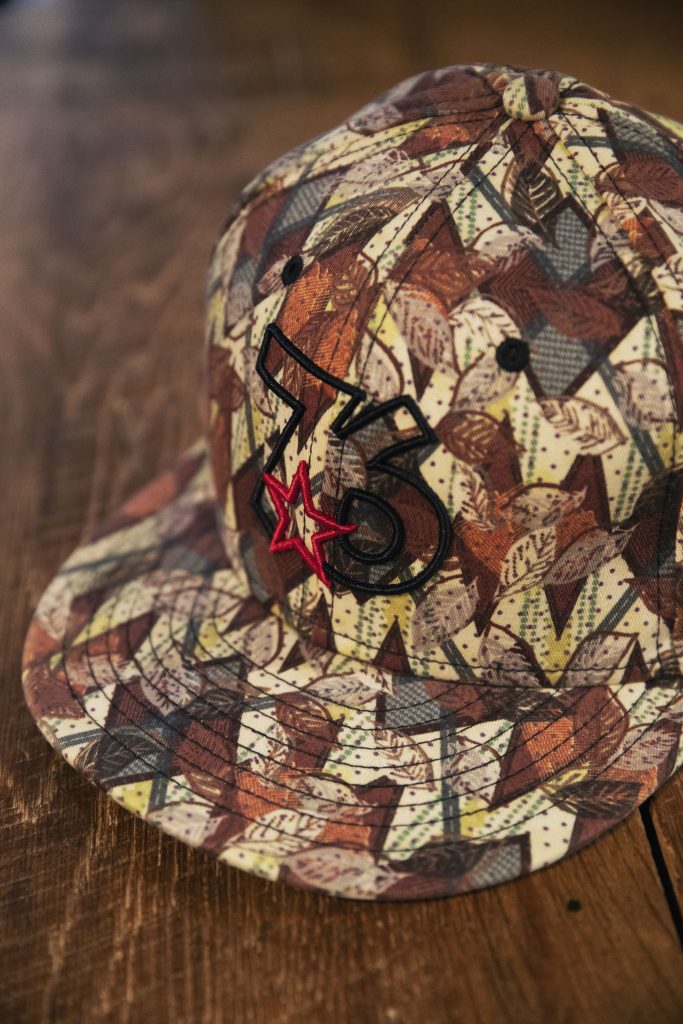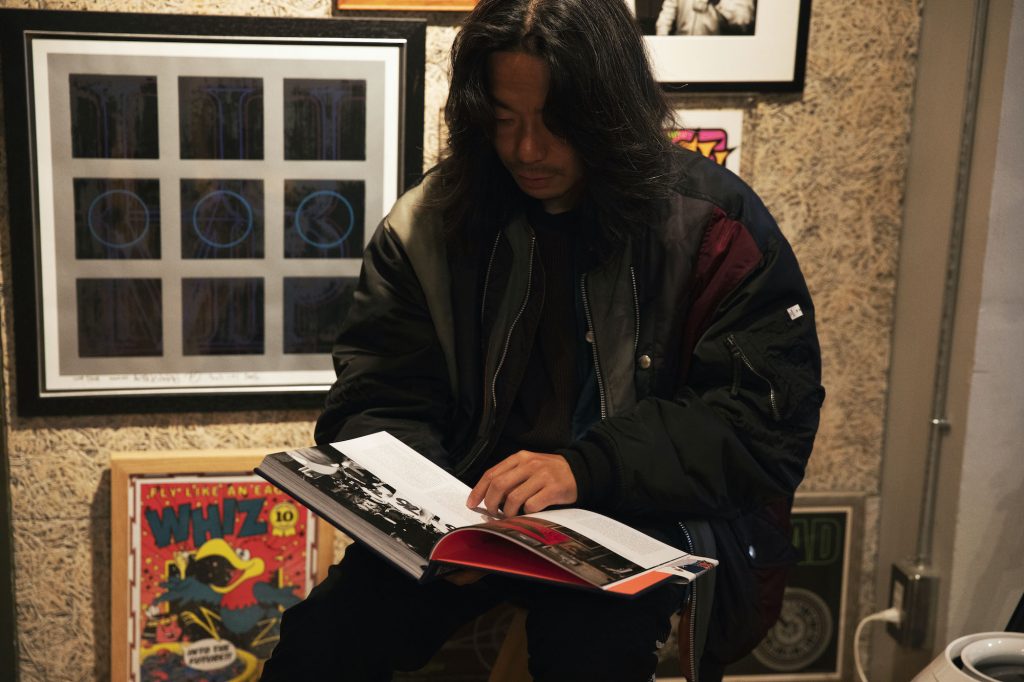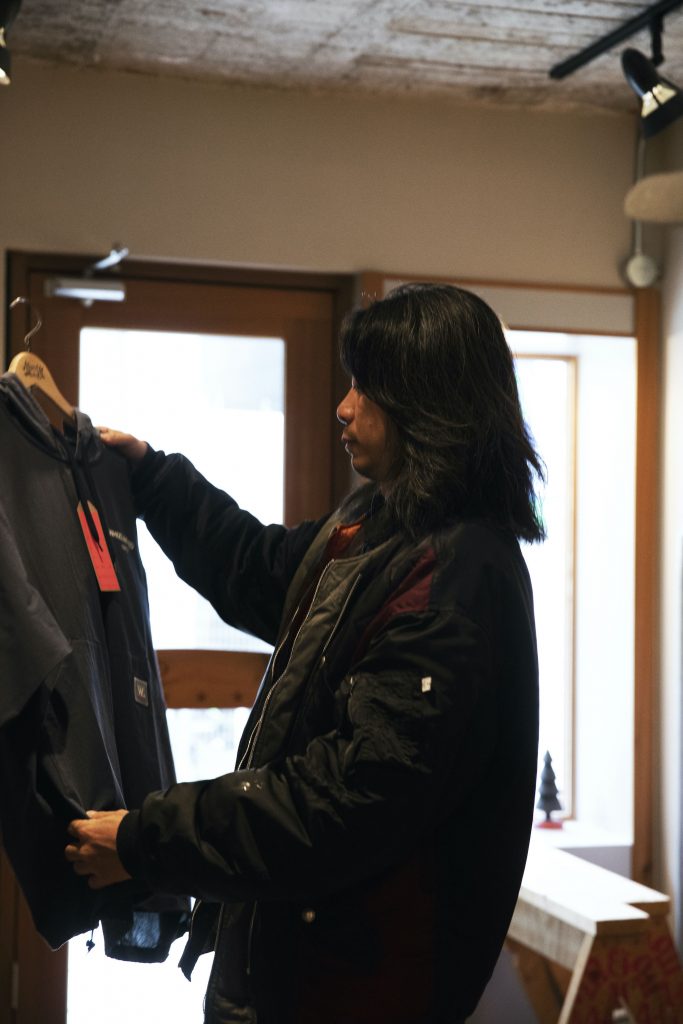Talking about their "20 years in Harajuku".
Edit&Text by Yukihisa Takei(HONEYEE.COM)
Photo by Kiyotaka Hatanaka
Movie Directed by Ryoji Kamiyama

WHIZLIMITED, by Hiroaki Shitano, started its collection in Harajuku in 2000, and a large-format book documenting the brand's 20 years has been published this spring by the prestigious American publishing house Rizzoli. The brand FACETASM, which has made a name for itself overseas, was started by Hiromichi Ochiai in 2007 and has now been established for 15 years. Born and raised in Tokyo, the two designers - Shitano, born in 1976, and Ochiai, born in 1977 - are actually close friends in their personal lives. They come from slightly different fields - street and high fashion - but both have their roots in Harajuku. Here, we've asked the two designers about their creations and 20 years in Harajuku.

A strange relationship between "neighbourhood designers"
For this interview, the two designers met up at the FACETASM aoyama store in Omotesando, then walked to the WHIZLIMITED store WHIZ TOKYO in Uraharajuku together. The conversation started off in the store.
- Where did you two meet for the first time?
Hiroaki Shitano (S): It was at VERSUS TOKYO, which was run by Yoshii (Yuichi) san.
Hiromichi Ochiai (O): It was 2012, at the first show after the 3.11 earthquake. I knew about Shitano-san through the media, and I also knew that he was my neighbour.
S: You knew where I lived (laughs).
O: And it was a five-second run away (laughs). We still have friendly relations with our whole family even after I moved out of that area a few years ago. But 90% of our conversations are something personal, rather than about work.
S: We've known each other since our kids were still little, so we only talk about that kind of stuff.

- Shitano-san was born in 1976 and Ochiai-san in 1977. You two are in the same generation, right?
O: I graduated from Bunka Fashion College and the first textile company I worked for was in Harajuku. So I have been in Harajuku since I was 21, and I was seeing the success of Shitano-san and others. I started my brand a little later, at the age of 29.
- How old did you start your brand, Shitano-san?
S: When I was 24 years old.
O: That’s crazy, isn't it?
S: I know right? When I think about it now.
“We hit off well together immediately”

- Did you expect to get on this well with Shitano-san?
O: I thought we didn’t have anything in common, but we hit off well together immediately. He is a kind senior who always listens to me or maybe it's just me respecting him one-sidedly.
- It may be difficult to say in front of him, but what aspects do you respect?
O: The fact that he’s an unwavering person and also the way he interacts with people, even locals and kids. I think if I were to run for election in that area, he would be elected (laughs).
- You mentioned earlier that 90% of your conversations are personal, but what is it about the rest of the 10%?
S: I still remember that when Ochiai-kun won the Tokyo Fashion Award, we were having dinner together and I asked him, "By the way, what was that award about?”. Then, he told me that if I win that award, I get an opportunity to have an exhibition in Paris. I looked it up there, and I found out that the next day was the deadline (laughs). I rushed to make all the materials that day, and the next day I posted them to the post box at the Fashion Award Office on my own. Ochiai-kun often tells me things like that. (WHIZLIMITED won the award in 2015)
“No matter streetwear or high fashion, as a resident of Harajuku”

O: Rather, he often helps me out. For example, I was always wearing CONVERSE at a time and one of my goals was to collaborate with them, and Shitano-san said, "Well, I'll set it up". Then, Kunii (Shigeyuki) san from mita sneakers and the editor-in-chief of SHOES MASTER were also attending the first meeting with CONVERSE. With that line-up like that, they couldn't refuse (laughs).
S: Because you said you really like CONVERSE.
O: This is who he is. That's why people like him including myself. So I was just telling him the information that he probably wouldn’t know instead back then.
S: I'm really ignorant about that kind of thing. So I get that kind of new information from Ochiai-kun.
O: I was asking Shitano-san for advice at milestones in the early days of the brand, and there was no such thing as streetwear or high fashion there, but he was just giving me advice as a resident of Tokyo fashion, a resident of Harajuku.
S: Right, a resident of Harajuku (laugh).
Their own Ura-Harajuku

- Shitano-san, you started by selling hand-printed T-shirts in Harajuku and have been rooted in the area ever since. What made you decide to start your brand in Harajuku in the first place?
S: It all started when I bought a Mac right after I graduated from high school. I knew from something that I could do design with that machine, so I bought a textbook and taught myself how to make graphics. Then a friend of mine gave me a machine to print T-shirts, so I started printing my own designs. I also had a friend who had a shop in Harajuku, so I asked him to sell them too. That was in 1995 or 1995.
- Those were the times when the Urahara was very Urahara.
S: Maybe it's about the early days of the Urahara.

- How did you feel walking around Harajuku at the time, Ochiai-san?
O: I really liked all aspects of fashion, both high fashion and street, so I went to all kinds of clothing stores at the time. That’s why I was also wandering around Urahara. I saw the small NOWHERE store become popular worldwide, so naturally, I was influenced by them. I liked UNDERCOVER and A BATHING APE, but I didn't want to dress the same as other people, so I was looking at it as culture rather than clothing.
- Did you already have the idea that you would become a designer at that time?
O: Yes, I was really desiring. I graduated from Bunka Fashion College and wanted to be a designer while I was in my 20s, so I started FACETASM in May when I was 29, I would be 30 in August, so that was just in time (laughs).
The independent spirit of WHIZLIMITED

- Shitano-san, you didn't go to a fashion school or work at a fashion brand, so you really came out from the street.
S: I don't know if it's because of my generation or my values, but I thought 'making clothes is something you don't learn from other people'. I had the feeling since high school that it would be lame if I go to fashion school to study. I really wanted to be independent, and I thought it wasn't cool to work under someone, work for a big corporate, or listen to music coming out from a major music label. I was always rejecting the mainstream stuff.
- At that time, many independent brands emerged in the same way. But most of them are gone now, and how do you see the reason why WHIZLIMITED has lasted for so many years?
S: I've done everything with my own ideas. The rules of society don't mean anything to me, and I'm self-made in design and running a business. I experienced both good and bad things on my own. There were a lot of brands in our generation, while I was among the first, but they started by following the success stories of others. People like me suddenly started selling well, so others were like, " I'll do it too, I'll do it too". But the people who started later just follow the path predetermined by others, thinking that they can just copy. But they don't think on their own, so they get stuck at some point in the end.
- That’s very convincing.
O: Everyone wears WHIZLIMITED understanding those things, and clothes that tell such policy are actually not so many. I think that because the clothes reflect Shitano-san's emotions and identity, the feelings of the people who wear them are also very special. So while WHIZLIMITED is one of the Harajuku brands, it is more like "Shitano-san's brand".
Harajuku - a city that has always changed

- FACETASM's Harajuku store had a great atmosphere. It’s now moved to Omotesando, but was it because you fad a certain feeling of leaving Harajuku and going to Omotesando as the "next stage"?
O: No, it wasn't like that at all. I still like Harajuku even now. The Harajuku store was actually next door to the textile company where I got my first job when I was in my twenties, and that property was also a cafe owned by a good friend of mine. I just had to move out because of land development due to the Olympics.

- Omotesando and Harajuku are actually very close to each other as you both walked around here today. Even so, has anything changed in Harajuku as seen from Omotesando?
O: Harajuku has a unique rhythm, and I can still feel that there. When I was young, Harajuku was the first place where you would come to achieve your dreams, but I think the desire to succeed in Harajuku has faded away nowadays. The current young generation is cool, so I think there will always be some kind of movement, but it may not be necessarily in Harajuku. I kind of hope that it’s still in Harajuku though.
- Shitano-san, did you have any kind of determination in not to move from Harajuku?
S: It’s rather I don't know anywhere else but here as Harajuku is my home. Also, I don't have to go anywhere else.

- Having been in Harajuku for many years, how do you see the city changing?
S: It's a city that has always changed, isn't it? It has been changing even before we came here, and there’s no point to expect it to be unchanged. We knew beforehand that it would change over time. But some stores haven't changed. I see my store as like a greengrocer in this Urahara shopping arcade.
Collaboration is a form of communication

O: Urahara attracted attention from around the world, and even today, top designers such as the late Virgil Abloh and Kim Jones are definitely influenced. It was such a huge success that NIGO®-san became a designer for KENZO. But that period was a rare moment even in the world, I think it was really a miracle at that time. Also, collaborations and co-branded items are also a culture born in Urahara.
- WHIZLIMITED and FACETASM have actually worked together on a collaboration, too?
S: That was made for a shop that stocks both FACETASM and WHIZLIMITED in Sendai. So we didn't really make a big announcement or anything, and the regular customers there just buy it. And our kids are wearing it (laughs).
- So that’s a true "neighbors collaboration".
S: Yes, it was really. I also did a collaboration with New Era®, but that was like you buy a New Era® book to win an entry, so I only made a few of them.

- How do you normally get collaboration started?
S: In my case, the brands I've worked with approached me most of the time. The only people who I ask are friends like Ochiai-kun or my seniors from Urahara.
O: I think it's mostly the same in my case too. It’s just whether it fits our brand or not. But the only person I've collaborated with with who I'm closely connected is Shitano-san. Collaboration is a form of communication, so I feel like I want it to be more pure than business.
Many years make fashion stagnate?

- WHIZLIMITED has also published a book from Rizzoli that compiles 20 years of work.
O: This is the first time I've actually seen this today, but I heard they were making it. I was like, 'How come they can publish it from Rizzoli?'.
S: That's what a lot of people in this industry asked me.
O: But I can see why Shitano-san can make it happen. I thought it would be interesting as a brand book because he really has a strong belief in what he's been doing. How is the response?
S: It's sold out now so I heard everyone can't get it.
O: That means it's a good response (laughs). Because Shitano-san's got a unique sense of Tokyo culture. It's such a pleasure to be able to see it all in one book.

- Speaking of years and months, WHIZLIMITED is 22 years old. Ochiai-san’s FACETASM is 15 years. It's much harder to continue a brand than to launch a new brand.
S: But I personally think years are something that burdens fashion. The fashion industry is always seeking something fresh and new, I really don't think that an anniversary year is necessary. Fashion is something that is constantly going round and round, and that shouldn't be stagnated.
O: It's the same for me, not because I've been doing it for 15 years, it’s rather people offer me to do some special collaboration for the anniversary while I'm thinking of what I'm going to make next. That could be a motivation for me, too.
S: Yeah, that's really how I feel. I think we should use the anniversary year for something that pays back to the people who have supported us. But people from the outside look at those years and say it's great, so maybe the person who's actually doing it and the way they look at it from the outside are two different things.
O: That’s maybe true.
S: In the high fashion scene like Ochiai-kun works, if you look at the magazines from 10 years ago, a lot of brands have disappeared. I think that's crazy for being able to continue a brand in that kind of scene for 15 years. It needs a lot of power to compete in that scene.
O: I agree, I think it’s crazy to even for me (laughs).
- Did you have a certain desire to survive in such an environment?

O: Well, it's something that's more natural, rather than surviving, and it's a continuation of what I did because I just wanted to make something strong and create a new value. I try not to look at the past too much, because if I do that, all I would do is regret that "I should have done that". For example, why did I keep my hair that long (laugh)?
S: Is that what you regret? (Laughter). But I think Ochiai-kun is really doing well. He's been very tough and strong as the pressure and expectations to him are incredibly high, so I think it's amazing how he's managing everything in such kind of mentality. I get worried about him because we are friends.
O: Well, it's just because I don't think of anything (laughs). But no one can do the same thing as Shitano-san does. I'm very happy to be able to have a talk with Shitano-san like this, and I hope this relationship will continue for a long time, that’s now one of my goals for the future.
S: You wrap it up pretty good (laughs).

Hiroaki Shitano
Fashion designer
Born in 1976. Started out by selling hand-printed T-shirts in Harajuku and launched WHIZ in 2000. The brand has gained huge popularity from the streetwear scene and changed its name to WHIZLIMITED in 2003. The clothes produced based on Hiroaki Shitano's sense of style have attracted many fans, especially the anniversary items released every year on 6 July. He won the Tokyo Fashion Award in 2015.
Hiromichi Ochiai
Fashion designer
Born in 1977. After working for an apparel textile company, he founded FACETASM in 2007; made runway debut in 2011 and opened the first flagship store in Harajuku, Tokyo, in 2015. He won the Mainichi Fashion Award ’New Designer Award' in 2013. He was also selected for the finalist at the LVMH Young Fashion Designer Prize in 2016, and won the Mainichi Fashion Award 'Grand Prix' in the same year. FACETASM has collaborated with CONVERSE, THE WOOLMARK COMPANY, Coca-Cola, Disney Collection, NIKE's JORDAN series, Levi's® and many others. As for his personal work, he has also produced Convenience Wear in collaboration with the convenience store Family Mart since 2021.
[Editor’s note]
I knid of knew they are close to each other. After the interview, I found out that they are closer than I had imagined, but I could also tell that they both respect each other. They are good friends but keep a reasonable distance, and that kind of atmosphere was comfortable for me, too during the interview. (Takei)